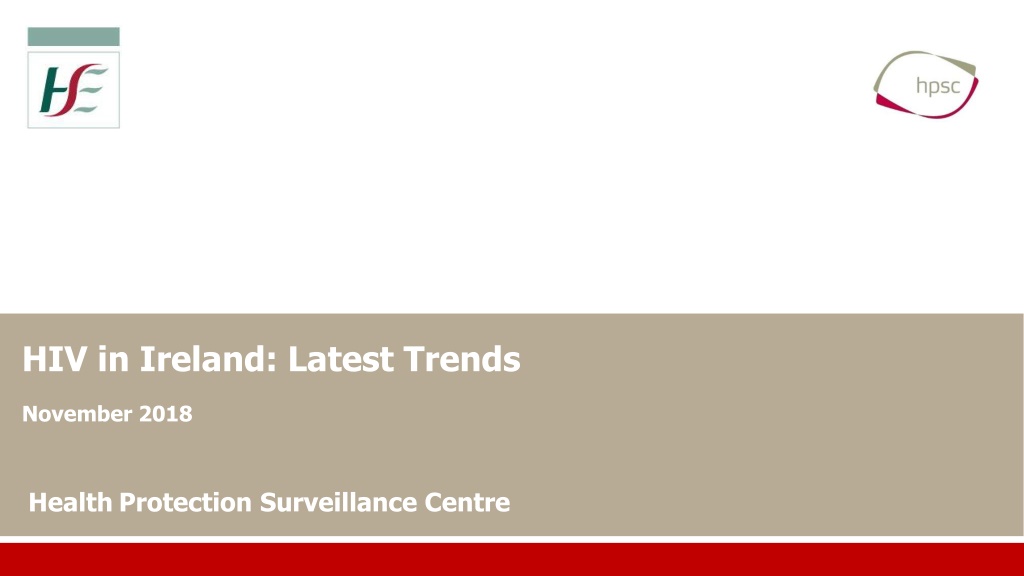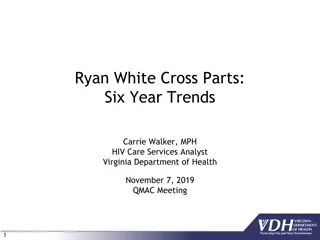HIV Diagnosis Trends in Ireland (November 2018)
The HIV diagnosis rate in Ireland has shown stability with some fluctuations between 2015 and 2017. There were increases and decreases in diagnosis rates among males and females, with notable trends in different age groups. Diagnoses among men who have sex with men slightly decreased, while there was an increase among heterosexuals. The rates differ based on the probable route of transmission and region of birth. Overall, the data reflects a complex scenario in HIV diagnosis trends in Ireland.
Download Presentation

Please find below an Image/Link to download the presentation.
The content on the website is provided AS IS for your information and personal use only. It may not be sold, licensed, or shared on other websites without obtaining consent from the author.If you encounter any issues during the download, it is possible that the publisher has removed the file from their server.
You are allowed to download the files provided on this website for personal or commercial use, subject to the condition that they are used lawfully. All files are the property of their respective owners.
The content on the website is provided AS IS for your information and personal use only. It may not be sold, licensed, or shared on other websites without obtaining consent from the author.
E N D
Presentation Transcript
HIV in Ireland: Latest Trends November 2018 Health Protection Surveillance Centre
Summary Diagnoses and Rates (slides 4-10) The HIV diagnosis rate in Ireland between 2015 and 2017 has remained relatively stable. Between 2014 and 2015, there was a large increase (30%) followed by a small increase (5%) between 2015 and 2016 and a slight decrease (2%) between 2016 and 2017. The rate among males decreased slightly in 2017 while the rate among females remained stable In males, the rate among those aged 25-29 years increased in 2017 while in females the rate increased among those aged 40-44 years. The highest rate between 2015 and 2017 was in HSE East. Diagnoses among those previously positive remained stable in 2017, accounting for 39% of diagnoses Excluding those with a previous positive HIV diagnosis, there was a 4% decrease in the number of diagnoses in 2017 2
Summary Probable route of transmission (slides 11-16) Diagnoses among men who have sex with men (MSM) decreased slightly in 2017. Diagnoses among heterosexuals increased between 2015 and 2017 having remained stable between 2010 and 2015. The increase is higher among those with a history of being previously HIV positive abroad. Since 2009, there have been less than 30 diagnoses per year among people who inject drugs (PWID), apart from in 2015 (n=49) when there was an outbreak of HIV among homeless PWID living in Dublin. Region of Birth (slides 17-18) Since 2003, the number of HIV diagnoses among those who were born in Ireland has been less than among those born abroad. The rate of HIV diagnosis among those born in Ireland has remained stable since 2003 while the rate among those born abroad has increased from 18 per 100,000 in 2011 to 38 per 100,000 in 2016 and 2017. 3
HIV diagnoses and rates 12.0 600 Change in case definition 10.0 500 Number of diagnoses 8.0 400 Rate per 100,000 6.0 300 4.0 200 2.0 100 0.0 0 2003 2004 2005 2006 2007 2008 2009 2010 Year 2011 2012 2013 2014 2015 2016 2017 Diagnoses Rate of Diagnosis (per 100,000)
HIV diagnoses by history of previous diagnosis abroad 400 350 300 250 Number of cases 200 150 100 50 0 2012 2013 2014 2015 2016 2017 Year of notification Previous positive Not previous positive/Unknown 5
Rates of HIV diagnosis by sex 20.0 18.0 16.0 Rate per 100,000 population 14.0 12.0 10.0 8.0 6.0 4.0 2.0 0.0 2003 2004 2005 2006 2007 2008 2009 2010 2011 2012 2013 2014 2015 2016 2017 Year Females Males 6
Rates of HIV diagnosis by age group 40.0 35.0 30.0 25.0 Rate oer 100,000 20.0 15.0 10.0 5.0 0.0 2003 2004 2005 2006 2007 2008 2009 2010 2011 2012 2013 2014 2015 2016 2017 Year 15-24 25-29 30-34 35-39 40-44 45-49 50+ 7
Rates of HIV diagnosis by age group in males 70.0 60.0 Rate per 100,000 population 50.0 40.0 30.0 20.0 10.0 0.0 2003 2004 2005 2006 2007 2008 2009 2010 2011 2012 2013 2014 2015 2016 2017 Year 15-24 25-29 30-34 35-39 40-44 45-49 50+ 8
Rates of HIV diagnosis by age group in females 35.0 30.0 Rate per 100,000 population 25.0 20.0 15.0 10.0 5.0 0.0 2003 2004 2005 2006 2007 2008 2009 2010 2011 2012 2013 2014 2015 2016 2017 Year 15-24 25-29 30-34 35-39 40-44 45-49 50+ 9
HIV notification rates by HSE Area 25.00 20.00 Rate per 100,000 15.00 10.00 5.00 0.00 HSE E HSE M HSE MW HSE NE HSE NW HSE S HSE SE HSE W Ireland HSE Area 2015 2016 2017 10
HIV diagnoses by route of transmission 300 250 200 Number 150 100 50 0 2003 2004 2005 2006 2007 2008 2009 2010 2011 2012 2013 2014 2015 2016 2017 Year MSM Hetero female Hetero Male PWID Unknown 11
HIV diagnoses by history of previous diagnosis abroad and route of transmission 200 180 160 140 120 Number 100 80 60 40 20 0 2012 2013 2014 2015 2016 2017 Year MSM New Hetero New PWID New MSM Prev pos Hetero Prev pos PWID Prev pos 12
HIV diagnoses among MSM by geographic origin 120 100 80 60 Number 40 20 0 2008 2009 2010 2011 2012 2013 2014 2015 2016 2017 Year Ireland Latin America W Europe C&E Europe S&SE Asia Unknown 13
HIV diagnoses among heterosexuals by sex 160 140 120 100 Number 80 60 40 20 0 2003 2004 2005 2006 2007 2008 2009 2010 2011 2012 2013 2014 2015 2016 2017 Year Male Female 14
HIV diagnoses among heterosexuals by geographic origin 200 180 160 140 120 Number 100 80 60 40 20 0 200320042005200620072008200920102011201220132014201520162017 Year From Sub-Saharan Africa From other areas 15
HIV diagnoses among people who inject drugs by sex 50 45 40 35 30 Number 25 20 15 10 5 0 2003 2004 2005 2006 2007 2008 2009 2010 2011 2012 2013 2014 2015 2016 2017 Year Male Female 16
HIV diagnoses by region of birth 350 300 250 Number 200 150 100 50 0 2003 2004 2005 2006 2007 2008 2009 2010 2011 2012 2013 2014 2015 2016 2017 Year of diagnosis Born in Ireland Born abroad 17
Rates of HIV diagnosis by region of birth 60.0 50.0 Rate per 100,000 population 40.0 30.0 20.0 10.0 0.0 2003 2004 2005 2006 2007 2008 2009 2010 2011 2012 2013 2014 2015 2016 2017 Year of HIV diagnosis Born in Ireland Born abroad 18
ExplanatoryNotes Data for this report were extracted from CIDR on 9th October 2018 and were correct at the time of publication. It is important to note that - the HIV surveillance system captures new diagnoses of HIV infection and therefore does not measure incidence. - persons newly diagnosed in Ireland may have been previously diagnosed with HIV in another country and are included in surveillance figures at first confirmatory test in Ireland. - data are presented by date of notification on CIDR (Computerised Infectious Disease Reporting) system 18
Further Information A detailed annual report on HIV in 2017 is available at http://www.hpsc.ie/a- z/hivstis/hivandaids/hivdataandreports/ Trend slides on HIV among MSM are available at http://www.hpsc.ie/a- z/hivstis/sexuallytransmittedinfections/dataonhivandstisamongmenwhohavesexwith menmsm/ Weekly HIV and STI reports are available at http://www.hpsc.ie/notifiablediseases/weeklyidreports/ 19
Acknowledgements In order to accurately track the HIV epidemic in Ireland and to assess the impact of HIV prevention programmes, it is essential to have good quality surveillance data. The production of this annual report is the result of a huge amount of work carried out by many people in collecting and collating the data. We would like to sincerely thank all of the data providers and all who have contributed to this report including: National Virus Reference Laboratory (NVRL) Microbiology laboratories Departments of Public Health Consultants in Infectious Disease/Genitourinary Medicine Infectious Disease Unit, Our Lady s Hospital for Children (OLHC), Crumlin for paediatric data GPs HIV clinical nurse specialists Health Advisors All other clinical staff involved. 21































